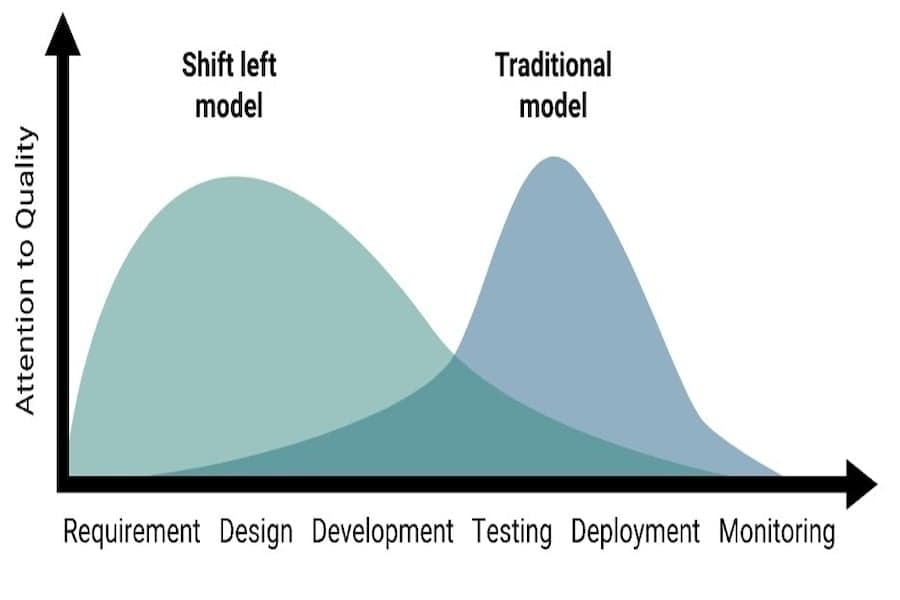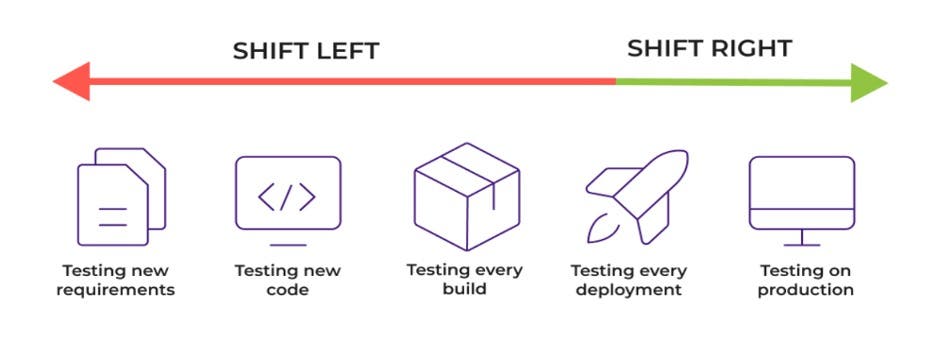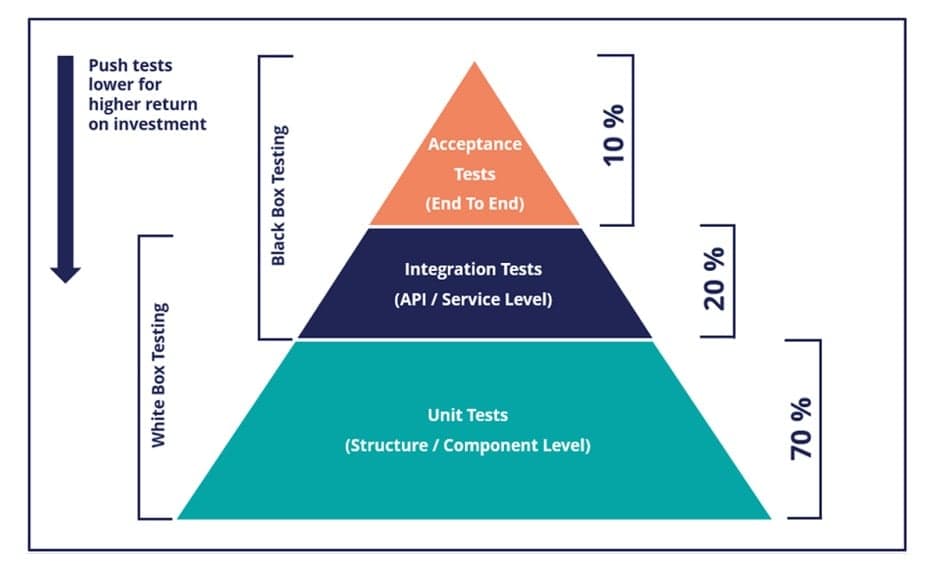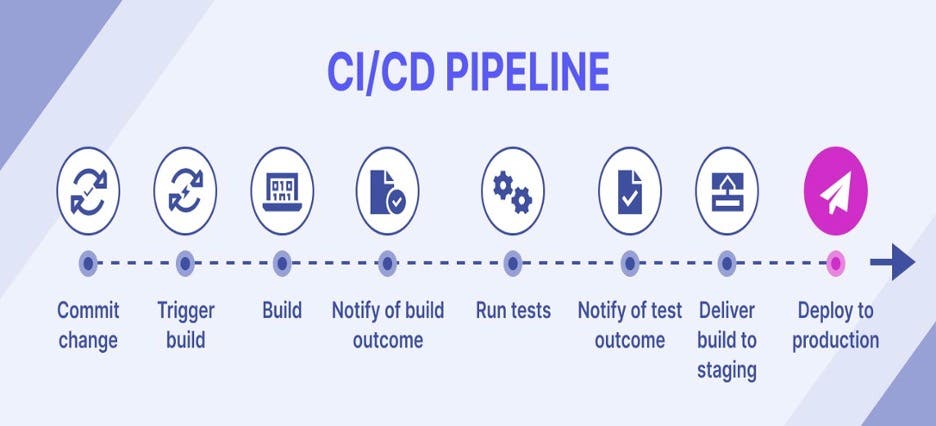Shift Left - A Paradigm in Software Quality Assurance
Jan 26, 2024
6 min read

Agile methodologies emphasize iterative and collaborative approaches, requiring a shift in the way testing is integrated into the software development process. A key aspect of this shift is ‘Shifting Left’, which involves integrating testing activities earlier in the Software Development Life Cycle. Ideally, this starts as early as the requirements, design, and planning phases to ensure more thorough and effective testing.
In contrast, the traditional Software Development Life Cycle, particularly in the waterfall model, delays the inclusion of testers. They are typically involved only after the development phase is complete, often just before the software is released into production. This late integration of testing can compromise the quality of the software, as potential issues may not be identified and resolved in a timely manner.
What is 'Shift Left'?
‘Shift Left’ testing is a methodology in software development that involves moving testing activities to the earliest possible stage in the Software Development Lifecycle (SDLC). This contrasts with traditional models where testing follows development, aiming to improve quality and efficiency by identifying issues earlier.
Why ‘Shift Left’?
‘Shifting Left’ in software development, where testing begins early in the SDLC, offers significant benefits. It enables early detection and resolution of issues and vulnerabilities, reducing the likelihood of major bugs appearing later in the development cycle. This improves efficiency, as fixing issues before context switching is easier and less disruptive. For developers, addressing a bug weeks or months after initial development can be challenging. Additionally, cost is a key factor; it's generally more cost-effective to fix defects earlier in the SDLC than later. Resolving issues during the development phase is less time-consuming and resource-intensive compared to doing so during later testing or post-release.
Consider the cost and time implications of a design defect found after a product has been delivered to the end consumer. Such a scenario would necessitate a complete rework of the product from start to finish in the SDLC to ensure that the new design changes are bug-free and do not negatively impact the customer acquisition and monetization.
The early emphasis on testing significantly impacts overall product quality. By integrating testing throughout the SDLC, it helps ensure that each software component meets the specified requirements. Frequent testing at all levels reduces the likelihood of bugs. The image below introduces a concept known as ‘Shift Right’ which complements the ‘Shift Left’ approach. ‘Shift Right’ involves testing activities after the product is deployed to the end consumers. Practices like User Experience Testing, A/B Testing, or Performance/Log Monitoring are examples of ‘Shift Right’. The choice between 'Shift Left' and 'Shift Right' depends on the product type and the company's objectives.

Starting testing early ensures thorough coverage, including unit, integration, and acceptance tests. This approach allows for quick bug fixes, reducing the manual testing team's workload, and lets them focus on functional and acceptance testing before the product's final delivery to the consumer.
How to ‘Shift Left’ in Software Development
Involve testers and developers in initial requirements gathering and project planning meetings. This step fosters collaboration between the development and testing teams and is crucial for understanding the project scope and objectives.
“Test the requirements”, this might sound unconventional, but it’s a critical step. Implement a three-step approach for this:
- Testers & Developers to review and sign off all the requirement and design documents.
- Testers should create a Test Plan and Use Cases document.
- All stakeholders, including Product Managers and Developers, should review and sign off on the Test Plan and Use Cases document.
This approach not only involves testers, who often have comprehensive knowledge of the product, from the start to identify issues or raise questions, but also provides confidence to Product Stakeholders that the product is being developed correctly.
Establishing a culture that prioritizes creating automated tests as a fundamental part of development is highly encouraged. The Test Pyramid model below advocates for writing a high volume of tests at the unit level, which can help identify issues early on.
In addition, developers are encouraged to take ownership of the quality of their code. Training them in testing practices and tools is key. For example, developers are responsible for writing integration tests, such as API and UI tests, for specific features. Automation Testers can serve as Subject Matter Experts, helping to set up test environments in the same repository where developers write code, or using the same coding language. They can assist in writing test cases, setting up element locators, and configuring CI to run these tests. This collaboration not only improves code quality and results in a bug-free product but also gives developers an insight into the testers' mindset. It is suggested to involve Product Managers in User Acceptance Testing, with Manual Testers acting as Subject Matter Experts. This collaboration can instill confidence in delivering a product that meets end consumer needs effectively.
 We can set up a CI/CD pipeline to automatically build, integrate, and deploy code changes. Incorporating automated unit and integration tests into the CI/CD process can catch issues early, providing developers with rapid feedback on their changes. Whenever code is updated at any stage of the process, our CI/CD setup should consistently run tests and automatically deploy the code if all tests passes. Conversely, it should notify stakeholders if any issues arise. Additionally, the CI/CD setup should include regular execution of regression tests to ensure that no new bugs are introduced.
We can set up a CI/CD pipeline to automatically build, integrate, and deploy code changes. Incorporating automated unit and integration tests into the CI/CD process can catch issues early, providing developers with rapid feedback on their changes. Whenever code is updated at any stage of the process, our CI/CD setup should consistently run tests and automatically deploy the code if all tests passes. Conversely, it should notify stakeholders if any issues arise. Additionally, the CI/CD setup should include regular execution of regression tests to ensure that no new bugs are introduced.

We can also leverage tools that continuously test code to provide quick and reliable feedback. These automated tools can help find new vulnerabilities in your code. For example:
- A lint and test coverage tool, like SonarQube or Code Climate, automatically checks your source code for programmatic and stylistic errors and measures real-time test coverage.
- An Accessibility Scanner scans the UI contents of your screen, suggesting improvements for app or website accessibility, focusing on aspects like Clickable Items, Content Labels, Text and Image Contrast.
In conclusion, ‘Shifting Left’ is about fostering a culture of responsibility, where everyone in an organization understands that their choices impact the quality of their application and its users. Prioritizing quality early saves time and accelerates innovation by preventing rework and reducing technical debt. Automation Test Strategies are vital to ‘Shifting Left’, leveraging tools to automatically detect or prevent vulnerabilities.
Most importantly, this requires a mindset change more than a technology one. It’s crucial to create processes that prioritize quality through the entire development process, rather than relying solely on specific tools. To build successful products, teams must focus on testing throughout the process instead of just at the end, preventing bugs rather than finding them, building the best system rather than breaking the system, and ensuring team responsibility for quality rather than leaving it solely to testers.
